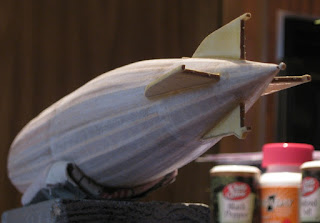I started working on the control car blank, again, today, December 22, and I notched the front of the car out for the windshield bulgeout, which I made as a separate piece. After that, I made the roof of the car, glued it on and flushed it up with the top of the car, and the windshield bulgeout. Then I shaped and installed the aft half bottom bulge that is on that end of the engine compartment of the control car. After that I cut out, shaped, and installed the two landing bumpers on the bottom of the car, both the fore and aft bumpers.
Here are pictures of today's progress, comparing the shape to this 1919 photo of the actual car, as well as checking it for size up against the model's plan sheet.
I have about five hours labor in this piece, by itself, now. I think the total labor time in the whole ship is now approaching about 77 hours.
Jim.

























































